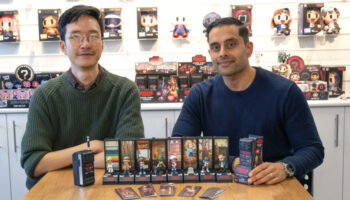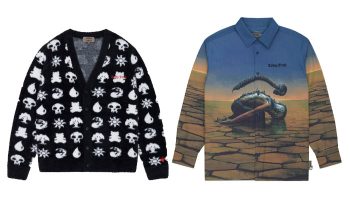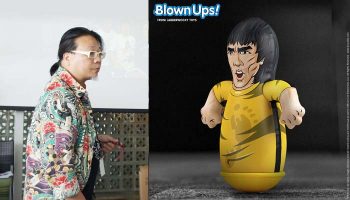Staff Designer Erica Bouyouris on developing games… And the best thing about working for Spin Master!

Erica Bouyouris… You seem to be a huge fan of games! What’s the appeal?
Games are fantastic entertainment, and a great way to spend time with friends and family. I grew up always playing games… Beside the classic board games, our house was very into card games; I have decades of memories of playing nightly cards at the cottage.
What was the appeal of card games, specifically?
I loved learning new card games! It was a great way to include just about any player count, and an easy way to meet new people; ask them to jump into a card game. Just about anyone is up for a game of cards! So I love games for two reasons: they’re social, and they’re brain food, meaning that they get your brain working in some way to play them. I appreciate the idea of facilitating both “the fun” and where games can be “clever”.
Good answer! And before you worked at Spin, you earned your stripes co-hosting The Meeple Syrup Show, and the podcast Ludology. Tell me how you got involved in those…
Most tabletop game designers that you meet will be self-taught. The reason for this is that it tends to be a genuine ‘jack of all trades’ job… It doesn’t have a clear guidebook on how to go about becoming a game designer. Being a game designer is often about information collecting as much as it’s trial and error, and developing good instincts. Being part of The Meeple Syrup Show, and later The Ludology Podcast, have been excellent ways to meet new people and in general educate myself about the gaming industry.

Interesting! It was part of an orientation program, in a way, then?
Yes, in a way, because I was also taking the leap to become part of it. Back when I had my first prototypes ready to start playtesting, I ended up meeting my first co-designer, Daryl Andrews, because I was helping to organise a prototyping convention in Toronto and we needed designers who’d be on panels. Daryl was one of the original co-hosts of Meeple Syrup and how I got started on that show.
Brilliant! So that came about quite organically? You just went for it?
Right. This industry is all about just trying and doing really. My time as a game designer – and being on Meeple Syrup – is where the opportunity to join Ludology came from. Being part of these two shows has been an incredible learning experience for me, and a great way for me to contribute back. I can now create content about the game industry that could help the next wave of new designers enter it.
One of your recent titles is Scott Pilgrim Miniatures the World. Can you tell us about it?
Scott Pilgrim is a fantastic comic from Oni Press, set in Toronto. It has all the fun and fantastic flare of a cartoon, a video game and a coming-of-age story rolled into one. It was amazing that I got approached to create this game as someone who was born and raised in Toronto. This comic and its following movie adaptation were HUGE there!

Really? Because people are excited to see Toronto on screen?
Well, more than that… Our city’s often in movies, but it’s usually called whatever American city the movie is pretending it is!
Oh, I see! They film in Toronto but pretend it’s Gotham, or what have you…
Exactly! So it was just really nice, especially at the time the movie came out, that the city got to be itself, and introduced people to a lot of iconic locations. I worked a lot of these places directly into the game as locations you can play at.
For example?
There’s Casa Loma… That’s a castle in the middle of Toronto; great Escape Rooms there! Lee’s Palace – one of the most famous clubs in Toronto. The Rockit is also in it: that was an older Toronto club; it’s no longer around. Oh, and the final board is the Chaos Theatre, which is a made-up place – so don’t look for that!
Ha! It’s a good job you said that; I can imagine people schlepping around in search of it! Is the game really just for fans, then?
No; the game’s designed for fans, obviously, but it’s also for people who might never have tried a minis/combat game before. I designed an easy dice system for players to test out their abilities and gain new and more powerful ones that let the game ramp up. There are 10 different characters so you can set up different levels or scenarios… Each has its own unique way of fighting. It was an amazing experience to be able to work on this game system with ONI Press and Renegade Games Studio.

Let me ask you this, Erica: how do you come up with an idea for a game? What inspires you?
I love the story!
The story?
The story! To me, “why” we’re doing anything in a game is really the structure or logic of it… Then it becomes a case of matching up mechanics that would let your players either experience or feel the things you’re trying to elicit. So if I want players to become a character in a game, say, then everything about how the game works should drive towards delivering that experience. Because really anything can be a game… Whether it’s any fun is a different question!
Does that suggest coming up with ideas is easy…
Well, the idea part is easy! The fun part not so easy. The best thing to do is to get the idea to the table as fast as possible to see if it has enough going for it to keep working. Game design is all about iteration and finesse, it really takes working at an idea enough to create a tangible, enjoyable experience out of it.
Good answer! I like that. Does it help to immerse yourself, then, to immerse yourself in that world?
I think so, for me; yes. I keep an eye on the kinds of games that are being released and spend a lot of time watching how-to-play videos so I can keep up with all the new titles coming out each year. I find learning how different games approach mechanics and stories a great inspiration. I find I’m often thinking to myself “How would I have done that?” or “What if I combined what this is doing with this other idea I’ve been trying to develop?” Games are fantastically inspiring for making even more games! You’ll often find that a lot of game designers first designs were usually variations of their favourite games.

This is great! And what’s your creative process after that initial spark?
I try to get the game right to the table. I like to make some parts; this helps force a few decisions to be made, and then I play through a couple of turns as if I were three people… I like to see what the best decision for each player would be. This forces more decisions to be made. There will still be rules that you didn’t even know you needed yet, but once most of the game’s logic structure is there, you should start putting it in front of people.
I’m very curious about that because I think a lot of new inventors are nervous about getting early feedback. They don’t want people annihilating their idea!
No, but there’s nothing better for feedback on how a game’s shaping up than watching the body positions and mannerisms of the people playing, combined with how they’re playing. I encourage play testers to talk through their turns with me and tell me when they get to decisions that they’re stuck on, or opportunities in play where they wish they had more options, or different options. It’s invaluable for shaping how the game plays and feels. All of these levels of testing also help shape your game designs instincts, slowly learning what inherently works or doesn’t.
You co-design a lot. What advantage is there, in your experience, to being a co-designer?
Co-designing can be the best combination of increased speed, imagination and experience that all come together to create a game that individual designers wouldn’t have done on their own. What takes one person a few weeks to work through might be decided in one conversation between co-designers. If you’re working with someone that’s compatible with your type of creativity, that is!

And what might make someone incompatible with your type of creativity?
Personally, I find it hard to work with people who fixate or say “No” quickly. I find it much easier to work with people who can be more ‘improv’ minded, allowing for a “Yes, and…” option.
The attitude here being that of an improv artist? Effectively saying “Yes, and…” so you’re always agreeing and building?
Yes, and meaning that ideas are constantly growing and evolving. It’s VERY rare, but I’ve found – on occasion – that there are just people who aren’t compatible for co-designing. Usually, it’s an excellent experience of collaboration and idea building from more than one perspective. I find them fantastic opportunities to see someone else’s way of thinking and creating. It’s a great way to learn and push your own design and communication skills as well.
And how did you come to work at Spin Master?
After being a freelance designer for about four or five years, I decided that – if I was going to go full time – now was the opportunity. I knew I wanted to work for a company as I’m not someone who’d make my full-time job freelance because there’s a bit too much risk and inconsistency for me! So when the opportunity came to work for Spin Master, I was ecstatic! I’d pitched games to them previously, and had a couple of projects started with them.

Just to clarify, what’s your job title there?
I’m a Staff Designer on the Games team! Working at Spin Master is a great opportunity to work on new and established brands for quite the span of age ranges. My role is to create and develop game play for children, family and adult games. Working with the awesome concept designers here, we collaborate to create visually stunning, fun games that often are set in some of your favourite movies and shows.
You’re fairly new to the role, but – so far – what’s the best thing about working for Spin?
Working for Spin Master obviously has other perks such as TOYS! My children have been overjoyed with amount of stuffed animals etc that they have gotten since I started work at Spin. They never seem to be as impressed with all the board games lying around but I supposed those are nothing new to them – ha!
Ha! Yes; I can imagine kids stepping over a lot of cool stuff to get even cooler stuff!
One of the hardest parts of freelance was guessing what publishers want. And it really was guesswork… I’m now half a year in, and there’s nothing that beats being told the exact creative brief. Now I know EXACTLY what the publisher’s looking for. I don’t have to guess the audience; I’m told it. One of the other fun perks is working with so many licences. As a freelancer, I was more fortunate than some, and worked with some fantastic properties. But that isn’t the norm in game design. Licences, especially those you love, are hard to find opportunities to work on. I now have the opportunity to work with licensors I never did before on such a large possible scope of designs and licences… I consider myself very lucky.

You’re the designer on a number of titles, including Steven Universe: Beach-a-Palooza, Kodama 3D, Bosk, Ghostbusters the Card Game, Roar: King of the Pride and Ink Monsters. What links them all? What quality do all your games have in common?
I personally find them all to be highly visual and immersive games. You’re almost always the character in my games and it’s rare that my games are considered ‘abstract’. As I said earlier, I love stories, especially in games. Many of the games you mentioned just then are IPs. That means there’s a fandom that knows these stories quite well, and have certain expectations about what they want the game to be. This is very different to creating something from scratch, when there are no preset expectations. Fandoms are quite different. I really appreciate getting to work on franchises that are beloved. I want to create games that are love letters to fans but are accessible to new audiences as well.
This has been terrific, Erica, thank you for making time for us. Final question: What’s the most interesting thing in your office or on your desk?
My house is bursting with games and toys… My office is a spillover of all of that as well. Most people notice my Charmander first when walking into my office.
Charmander, did you say?!
Yes; it’s a Japanese window display figure! But I made myself my own achievement wall as well… I display my published games along one wall of my office. I regularly stream and record so I try to keep what’s behind me looking nice and professional. The mess is on the other side of the camera.
I’d like to pretend I’m the exact opposite! That the mess you see on Zoom is the only mess! What does your mess comprise?!
Well… My mother-in-law often comments that my kids have too many toys. I have to remind her that most of them are actually mine – or my husband’s!
That’s a powerful argument! Erica, what a great pleasure to speak with you; thanks for making time.

–
To stay in the loop with the latest news, interviews and features from the world of toy and game design, sign up to our weekly newsletter here

























